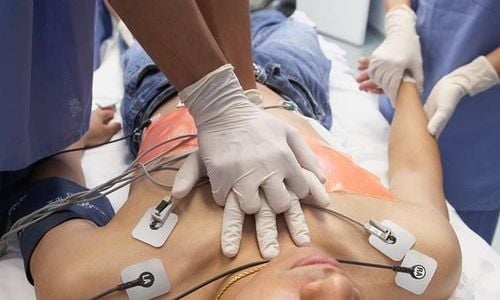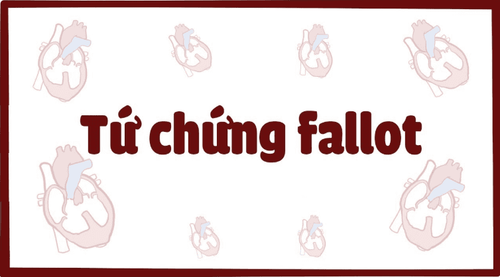This is an automatically translated article.
The article is professionally consulted by Master, Doctor Tran Hong Nhat - Interventional Cardiologist - Cardiovascular Center - Vinmec Central Park International General Hospital.Atrial malformation, commonly referred to as an atrial septal defect, is a congenital heart defect with an abnormal opening between the two atria. Depending on the characteristics of the deformity, it can affect the health of the affected person more or less.
1. How does a heart with an atrial septal defect work?
The normal heart is divided into four chambers, two on the right and two on the left. The heart must deliver blood to the lungs through blood vessels called the pulmonary arteries. In the lungs, the oxygenated blood then returns to the left chamber of the heart through the pulmonary veins, after which the left heart pumps the blood to the aorta and to the rest of the body.A heart with an atrial septal defect that allows blood to flow from the upper left chamber of the heart (left atrium) into the right upper chamber of the heart (right atrium). This mixed blood is then pumped into the lungs.
If the defect is large, blood flow to the lungs increases, increasing the pressure in the lungs (pulmonary hypertension) and leading to overwork of the right chamber of the heart. If left untreated, the right side of the heart will expand and become weakened.

2. Classification of atrial malformations
Secondary vent (Secundum). This is the most common type of atrial septal defect, the septum is located between the atrial septum Primary (Primum). The defect is located in the lower part of the atrial septum, often associated with other congenital heart problems. Sinus venosus (Sinus venosus). This is a rare defect where the hole in the vein drains into the coronary sinus. This rare defect is caused by a missing part of the septum between the coronary sinus and the right atrium.3. Risk factors for atrial malformation
It is difficult to know why congenital heart defects occur or occur with other genetic problems, such as Down syndrome.Research indicates a number of conditions that occur during pregnancy that can increase the risk of having a baby with a heart defect, including:
● Getting rubella (German measles) during the first few months of pregnancy
● Using certain drugs, tobacco, alcohol, or other addictive substances such as cocaine during pregnancy
● Mother with diabetes or lupus
People with Phenyl ketoneuria and who do not follow a proper eating plan may have ability to have a baby with a heart defect.
4. Symptoms of atrial malformation
Many children are born with atrial malformations but have no associated signs or symptoms. In most cases, symptoms begin to appear between the ages of 20 and 30. In some cases, signs and symptoms do not occur for many years.
Signs and symptoms of an atrial septal defect may include: fatigue, shortness of breath, shortness of breath, shortness of breath especially with exertion or edema, stroke.
Large atrial septal defects, if not detected and treated promptly, can reduce life expectancy due to problems such as arrhythmias, pulmonary hypertension or heart failure. Therefore, early detection examination to correct defects helps prevent the complications they bring.

5. Complications of atrial malformation
A small atrial defect may not cause unusual symptoms. But for larger defects that can cause some serious problems such as:
Arrhythmia : Atrial fibrillation is a common arrhythmia complication, it causes an uncomfortable feeling of nervousness. In particular, atrial fibrillation facilitates the formation of blood clots in the heart, which then cause embolic complications Pulmonary hypertension: If a large atrial septal defect is left untreated, increased blood flow to the lungs increases the pressure in the pulmonary arteries (pulmonary hypertension). Early-stage pulmonary hypertension can return to normal when abnormality is corrected Eisenmenger's syndrome: A late stage of the disease, when pulmonary hypertension is severe, irreversible, blood flow is diverted from right atrium to left atrium. Heart failure: The first stage is right heart failure with symptoms of massive liver edema and difficulty breathing. At the end of the pathology is total heart failure
6. Atrial malformations and pregnancy
Most women with an atrial septal defect can go through pregnancy without problems.
However, for those with problems such as heart failure, severe arrhythmias, or pulmonary hypertension that may increase the risk of complications during pregnancy, close monitoring is required
In particular, for Women with severe pulmonary hypertension or Eisenmenger syndrome should not become pregnant as it can be life-threatening.
7. Prevention of atrial malformations
There is not yet a specific prevention method for atrial malformations, for women who are planning to become pregnant, some measures should be taken to prevent triggers such as:
Perform fertility testing immunity to rubella. If not immune, consider getting the rubella vaccine, but it must be done before becoming pregnant. Actively monitor some health problems during pregnancy. Your doctor may recommend adjusting or stopping certain medications before you get pregnant. Check medical history of family members. If there is a family history of heart defects or other genetic disorders, consider determining your risk of having a baby with a birth defect before pregnancy. To protect cardiovascular health in general and detect early signs of cardiovascular disease, customers can sign up for Cardiovascular Screening Package - Basic Cardiovascular Examination of Vinmec International General Hospital. The examination package helps to detect cardiovascular problems at the earliest through tests and modern imaging methods. The package is for all ages, genders and is especially essential for people with risk factors for cardiovascular disease.
Please dial HOTLINE for more information or register for an appointment HERE. Download MyVinmec app to make appointments faster and to manage your bookings easily.
References: Mayoclinic.org














